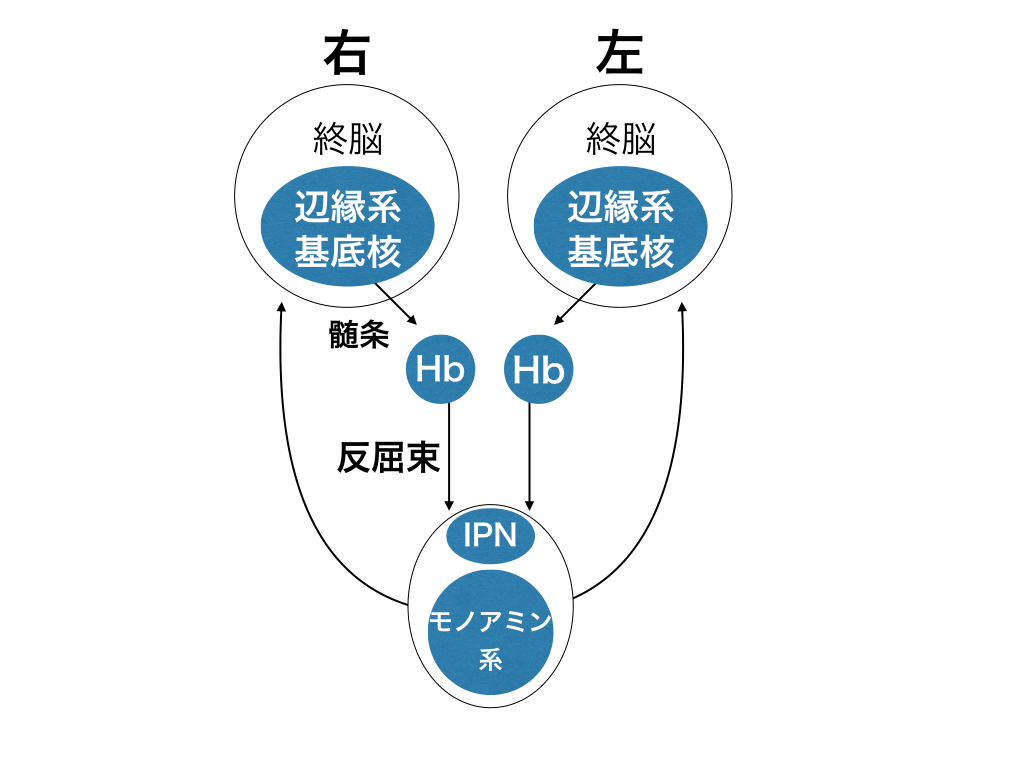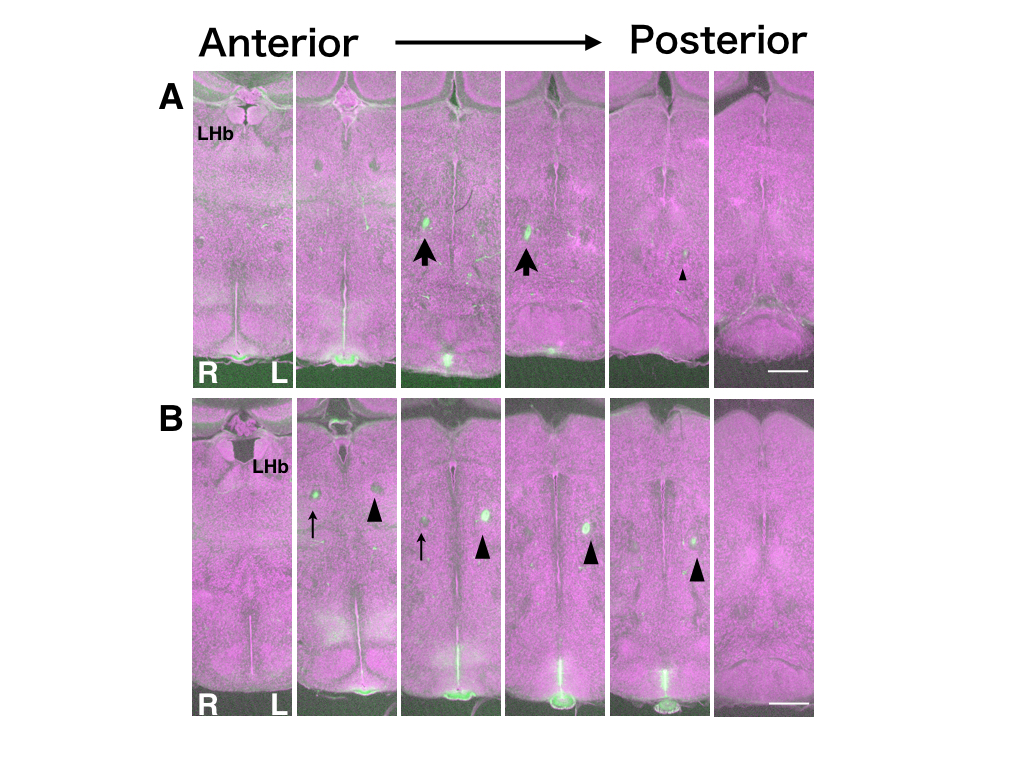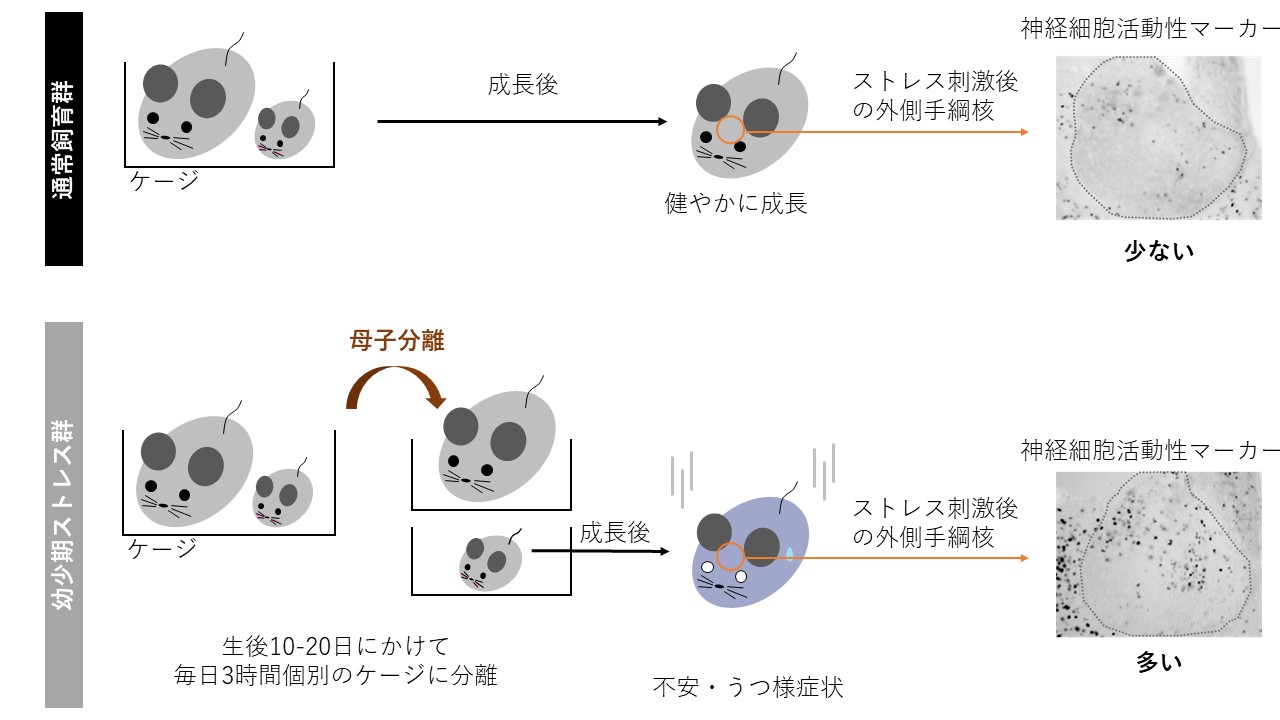Research 1: Development and Evolution of Asymmetry in the Habenula (Ichijo & Nakamura)
Asymmetry in neural circuits is widely reported in vertebrates and can be categorized into two types. One is associated with spatial asymmetry in the external environment and involves asymmetric behavior. The other is less related to external spatial asymmetry and does not involve asymmetric behavior. A representative example of the latter is the habenula. Located dorsally in the diencephalon, the habenula receives diverse inputs from the telencephalon and outputs to monoaminergic circuits in the midbrain, regulating the entire central nervous system (Figure 1). It is highly conserved among vertebrates, suggesting its essential role in survival. Moreover, the habenula has been reported to be asymmetric in size between the left and right sides since the early 20th century.

Figure 1. Neural circuits of the habenula (Hb). Hb acts as a hub that spreads unilateral information bilaterally, regulating overall behavior.
The habenula is involved in various phenomena such as waking and sleeping, circadian rhythms, reward and punishment, escape and freezing responses to threats, winning and losing in social conflicts (e.g., fights), and stress responses. Despite its involvement in diverse phenomena, its functions appear disorganized, making it difficult to grasp its essence. We are exploring the fundamental functions of the habenula and how its lateralization evolved.
We hypothesize that the habenula is not specifically involved in each reported behavior but rather in common elements shared among them. We found that these behaviors are functionally incompatible binary oppositions. Binary opposition is considered an innate trait that heuristically formulates the world and compresses information. When functional incompatibility acts as a natural selection pressure, parallel neural circuits may evolve. In the habenula, such circuits may be allocated to the left and right sides of the brain, resulting in asymmetric neural circuits that are shorter and simpler. Avoiding redundant circuits on both sides also improves information transmission efficiency and increases fitness. Based on this theoretical framework, we aim to experimentally clarify the evolution of habenular asymmetry. We demonstrated that although the mouse habenula is structurally symmetric, it functions asymmetrically (Figure 2). Mice are thought to possess functionally asymmetric circuits that flexibly process information in complex environments. To understand interspecies differences in evolutionary strategies, we are investigating changes in sensitivity during habenular development and upstream circuits that guide lateralization.

Figure 2. Asymmetric activity in the lateral habenula. In genetically modified mice that label neural activity history, asymmetry is observed (arrow: right side, arrowhead: left side).
Development of the Lateral Habenula and Early-Life Stress (Nakamura & Ichijo)
The lateral habenula (LHb), located dorsally in the diencephalon, receives stress and aversive stimuli from the basal ganglia and limbic system and regulates monoaminergic circuits in the midbrain, such as the ventral tegmental area and dorsal raphe nucleus. It is thought to control reward/aversion processing, cognition, and emotion. Overactivity of the LHb has been reported in patients with depression and in rodent models of anxiety and depression. Local administration of GABAergic drugs that suppress LHb activity alleviates these symptoms, suggesting that LHb overactivity contributes to the onset of anxiety and depression.
We examined neural circuit changes in the mouse LHb from early life to adulthood and found that the LHb matures through four stages. Notably, during the second stage (postnatal days 10–20), LHb neurons showed significantly increased activity in response to stress.
Mice subjected to repeated maternal separation stress during this second stage exhibited fewer parvalbumin-positive neurons and heightened LHb activity in response to stress in adulthood (Figure 3). These mice also developed anxiety- and depression-like behaviors. Since no changes were observed in other stress-related brain regions, we believe that specific changes in LHb cells contribute to behavioral alterations. However, mice exposed to chronic stress during postnatal days 1–9 or 36–45 did not show increased LHb activity. These findings suggest a “critical period” in early life when the brain is particularly susceptible to experience. We are exploring LHb circuits to better understand this “critical period for emotion.”

Figure 3. Mice subjected to repeated maternal separation stress during postnatal days 10–20 exhibit anxiety- and depression-like behaviors and increased LHb activity in response to stress. The dotted area shows the mouse LHb.
参照) Nakamura T, Kurosaki K, Kanemoto M, Sasahara M, Ichijo H. Early-life experiences altered the maturation of the lateral habenula in mouse models, resulting in behavioural disorders in adulthood. J Psychiatry Neurosci. 4;46(4):E480-E489. 2021.
